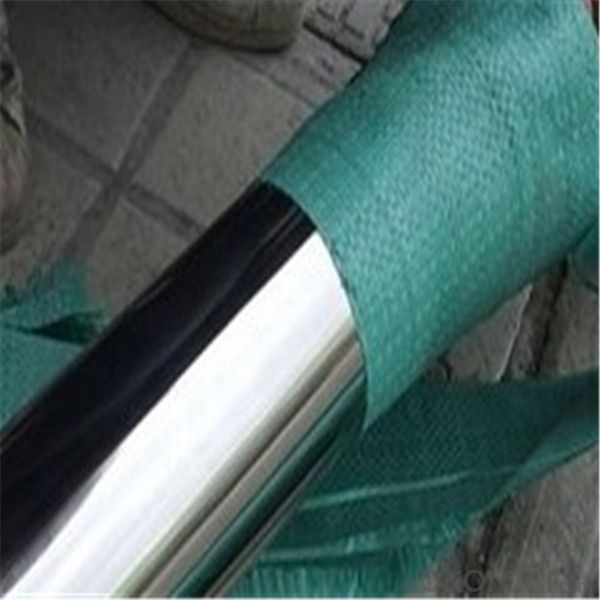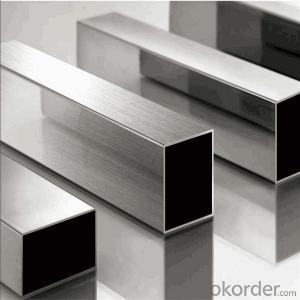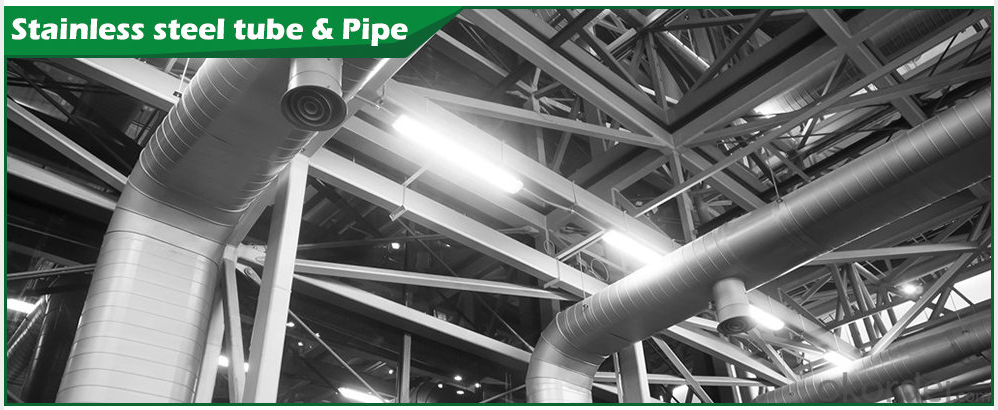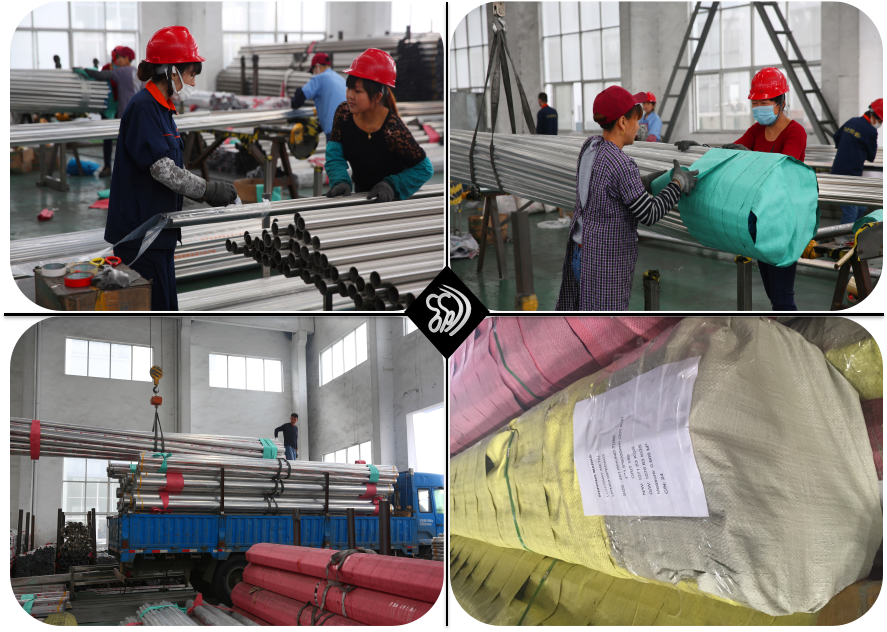304 316L Stainless Steel Pipe Price (ISO Certified factory direct price )
- Loading Port:
- Shanghai
- Payment Terms:
- TT OR LC
- Min Order Qty:
- 2 m.t.
- Supply Capability:
- 25000 m.t./month
OKorder Service Pledge
OKorder Financial Service
You Might Also Like
Item specifice
316 stainless steel pipe
Name | Stainless Steel Seamless & Welded Tube &Pipe | |||||
Items | Square tubes, round tubes, oval pipes, special shaped pipes, empaistic pipes, fittings | |||||
Standard | ASTM A554, A249, A269 and A270 | |||||
Material Grade | 201: Ni 0.8%~1% | |||||
202: Ni 3.5%~4.5% | ||||||
304: Ni 8%, Cr 18% | ||||||
316: Ni 10%, Cr 18% | ||||||
316L: Ni10%~14% | ||||||
430: Cr16%~18% | ||||||
Outer Diameter | 9.53mm--159mm | |||||
Thickness | 0.3mm - 3.0mm | |||||
Length | 6m or as customers' request | |||||
Tolerance | a) Outer Diameter: +/- 0.2mm | |||||
b) Thickness: +/- 0.02mm | ||||||
c) Length: +/- 5mm | ||||||
Surface | 180G, 240G, 320G Satin / Hairline 400G, 600G Mirror finish | |||||
Application | handrail,railing, staircase, weldmesh screen,door,window, balcony,fence,bench,furniture,etc | |||||
Test | Squash test, extended test, water pressure test, crystal rot test, heat treatment, NDT | |||||
Chemical Composition of Material | Material
Composition | 201 | 202 | 304 | 316L | 430 |
C | ≤0.15 | ≤0.15 | ≤0.08 | ≤0.035 | ≤0.12 | |
Si | ≤1.00 | ≤1.00 | ≤1.00 | ≤1.00 | ≤1.00 | |
Mn | 5.5-7.5 | 7.5-10 | ≤2.00 | ≤2.00 | ≤1.00 | |
P | ≤0.06 | ≤0.06 | ≤0.045 | ≤0.045 | ≤0.040 | |
S | ≤0.03 | ≤0.03 | ≤0.030 | ≤0.030 | ≤0.030 | |
Cr | 13-15 | 14-17 | 18-20 | 16-18 | 16-18 | |
Ni | 0.7-1.1 | 3.5-4.5 | 8-10.5 | 10-14 | ||
Mo | 2.0-3.0 | |||||
Mechanical Property | Material Item | 201 | 202 | 304 | 316 | |
Tensile Strength | ≥535 | ≥520 | ≥520 | ≥520 | ||
Yield Strength | ≥245 | ≥205 | ≥205 | ≥205 | ||
Extension | ≥30% | ≥30% | ≥35% | ≥35% | ||
Hardness (HV) | <105 | <100 | <90 | <90 | ||
Definition of stainless steel(Adopted form Wikipedia)
In metallurgy, stainless steel, also known as inox steel or inox from French "inoxydable",
is defined as a steelalloy with a minimum of 10.5% to 11% chromium content by mass.
Stainless steel does not readily corrode, rust or stain with water as ordinary steel does,
but despite the name it is not fully stain-proof, most notably under low oxygen, high salinity,
or poor circulation environments. It is also called corrosion-resistant steel or CRES
when the alloy type and grade are not detailed, particularly in the aviation industry.
There are different grades and surface finishes of stainless steel to suit the environment
the alloy must endure. Stainless steel is used where both the properties of steel
and resistance to corrosion are required.
Surface Finish :
Surface finish | Characteristics and application |
No.2B | The surface brightness and flatness of no2B is better than no2D. then through a special surface treatment to improve its mechanical properties, No2B could nearly satisfy comprehensive uses. |
No.3 | Polished with abrasive belt of git#100-#200, have better brightness with discontinuous coarse stria, used as inner and external ornaments for building, electrical appliances and kitchen utensils etc. |
No.4 | Polished with abrasive belt of grit #150-#180,have better brightness with discontinuous coarse stria, but thinner than No3, are used as bathtub buildings inner and external ornaments electrical appliances kitchen utensils and food processing equipment etc. |
HL | Polished with abrasive belt of grit #150-#320 on the NO.4 finish and has continuous streaks, mainly used as buildings ornaments elevators, door of building, frontal plate etc. |
BA | Cold rolled, bright annealed and skin-passed, the product have excellent brightness and good reflexivity like mirror, kitchen apparatus, ornament etc. |
8K | The product have excellent brightness and prefer reflexivity can to be the mirror. |
Mechanical Properties: MaterialY.S(N/MM2)T.S(N/MM2)ElongationHRB304>205>520>40<95304l>175>480>40<90316>205>520>40<90316l>175>480>40<90430>205>450>22<89
Applications: SurfaceApplication2BMedical equipment, Food industry, Construction material, Kitchen utensils.BAKitchen utensils, Electric equipment, Building construction.No.1Chemical tank, pipe.No.4Kitchen utensils, Building construction,Medical equipment.HLBuilding Construction.
|
| ---Packing & Transport--- Packing
Transport
|


- Q:What is the difference between nominal size and actual size in stainless steel pipes?
- The distinction between nominal size and actual size in stainless steel pipes lies in their measurement and labeling methods. Nominal size refers to the assigned name of a pipe based on its approximate dimensions, typically in inches or millimeters. This name serves the purpose of easy identification and standardization. In contrast, actual size refers to the precise measurements of the pipe, including its outer diameter (OD) and wall thickness. These measurements are usually expressed in fractions of an inch or millimeters. The accurate dimensions are vital for determining the pipe's compatibility with fittings, valves, and other components, as well as for calculating flow rates and pressure ratings. It is important to acknowledge that the nominal size of a stainless steel pipe may not always align with its actual size. This discrepancy arises from historical factors and manufacturing practices. In certain instances, the nominal size may be slightly larger or smaller than the actual size to account for variations in wall thickness or to conform to industry standards. Therefore, when selecting stainless steel pipes, it is crucial to consider both the nominal size and the actual size to ensure proper fit and functionality. Referring to the manufacturer's specifications or seeking professional advice can aid in determining the appropriate pipe size for a specific application.
- Q:What are the common sizes of stainless steel pipes used in construction?
- The common sizes of stainless steel pipes used in construction vary depending on the specific application and requirements. However, there are a few standard sizes that are commonly used in various construction projects. These include 1/2 inch, 3/4 inch, 1 inch, 1.5 inches, 2 inches, 3 inches, 4 inches, 6 inches, and 8 inches. These sizes are commonly used for different purposes. Smaller sizes like 1/2 inch, 3/4 inch, and 1 inch are often used for plumbing and water supply systems in residential and commercial buildings. They are also used for gas lines and ventilation systems. Larger sizes like 1.5 inches, 2 inches, 3 inches, and 4 inches are typically used for industrial applications such as oil and gas pipelines, chemical processing plants, and power generation facilities. These pipes are designed to handle higher flow rates and pressure requirements. Even larger sizes like 6 inches and 8 inches are used in more specialized applications such as large-scale industrial projects and infrastructure development. These sizes are often used for water treatment plants, wastewater treatment facilities, and large-scale irrigation systems. It is important to note that these are just some of the common sizes, and there are many other sizes available depending on the specific needs of a construction project. Consulting with a professional engineer or contractor is always recommended to determine the appropriate size of stainless steel pipes for a specific construction project.
- Q:What is the average cost of stainless steel pipes?
- The average cost of stainless steel pipes can vary depending on various factors such as the size, grade, and supplier. On average, stainless steel pipes can range from $5 to $20 per foot. However, it is recommended to obtain quotes from multiple suppliers to get a more accurate and current price.
- Q:What does "stainless steel pipe 201304" mean?
- 304 is a versatile stainless steel which is widely used in the manufacture of equipment and parts requiring good overall performance (corrosion resistance and formability). In order to maintain the inherent corrosion resistance of stainless steel, steel must contain more than 18% chromium, more than 8% of the nickel content. 304 stainless steel is a brand of stainless steel produced according to the ASTM standard in the United states.
- Q:Can stainless steel pipes be used for air conditioning systems?
- Yes, stainless steel pipes can be used for air conditioning systems. Stainless steel is a durable and corrosion-resistant material, making it suitable for various applications, including air conditioning systems. Stainless steel pipes offer excellent resistance to oxidation and rust, ensuring longevity and preventing leaks. Additionally, stainless steel pipes can withstand high temperatures and pressure, making them ideal for use in air conditioning systems.
- Q:Can stainless steel pipes be insulated with asbestos?
- Insulating stainless steel pipes with asbestos is not recommended due to its hazardous nature. Asbestos has been linked to severe health hazards, such as mesothelioma and lung cancer. The dangers of asbestos exposure are widely acknowledged, leading to its prohibition in numerous countries. Fortunately, there are numerous alternative insulation materials that are both safer and more effective than asbestos. These options include fiberglass, mineral wool, and foam insulation. These materials possess exceptional thermal insulation properties while eliminating the health risks associated with asbestos. When selecting an insulation material for stainless steel pipes, it is crucial to consider the specific requirements of the application and adhere to the necessary safety standards. Seeking guidance from a professional insulation contractor or engineer is always advisable to ensure the correct insulation material is chosen.
- Q:Are stainless steel pipes suitable for petrochemical plants?
- Yes, stainless steel pipes are highly suitable for petrochemical plants. They possess excellent corrosion resistance, high temperature strength, and durability, making them ideal for handling various aggressive chemicals and fluids found in petrochemical processes. Additionally, stainless steel pipes can withstand high pressure and maintain their structural integrity, ensuring the safety and longevity of the plant's operations.
- Q:Can stainless steel pipes be annealed?
- Yes, stainless steel pipes can be annealed. Annealing is a heat treatment process that can improve the ductility, toughness, and machinability of stainless steel pipes by reducing internal stresses and increasing their overall strength.
- Q:Difference between stainless steel and steel pipe
- Stainless steel (Stainless Steel) is referred to as the stainless steel, the resistance of air, steam, water and other weak corrosive medium or with stainless steel known as stainless steel; while the resistance to chemical corrosion (acid, alkali and salt chemical etching) corrosion of steel called acid resistant steel. Because of the difference in the chemical composition of the two, and make their corrosion resistance is different, ordinary stainless steel is generally not resistant to chemical medium corrosion, and acid resistant steel are generally stainless steel.
- Q:Are stainless steel pipes suitable for mining operations?
- Stainless steel pipes are a suitable choice for mining operations due to their durability and resistance to corrosion. The mining industry often exposes pipes to harsh chemicals, high temperatures, and abrasive materials. These conditions can quickly degrade regular pipes. However, stainless steel pipes are renowned for their exceptional corrosion resistance, enabling them to withstand the challenging mining environment. They also possess high tensile strength, allowing them to endure stress and pressure during the mining process. Additionally, stainless steel pipes are easy to clean. This is crucial in mining operations as it prevents contamination and maintains system efficiency. In conclusion, stainless steel pipes offer a dependable and long-lasting solution for mining operations, making them highly suitable for this industry.
1. Manufacturer Overview |
|
|---|---|
| Location | |
| Year Established | |
| Annual Output Value | |
| Main Markets | |
| Company Certifications | |
2. Manufacturer Certificates |
|
|---|---|
| a) Certification Name | |
| Range | |
| Reference | |
| Validity Period | |
3. Manufacturer Capability |
|
|---|---|
| a)Trade Capacity | |
| Nearest Port | |
| Export Percentage | |
| No.of Employees in Trade Department | |
| Language Spoken: | |
| b)Factory Information | |
| Factory Size: | |
| No. of Production Lines | |
| Contract Manufacturing | |
| Product Price Range | |
Send your message to us
304 316L Stainless Steel Pipe Price (ISO Certified factory direct price )
- Loading Port:
- Shanghai
- Payment Terms:
- TT OR LC
- Min Order Qty:
- 2 m.t.
- Supply Capability:
- 25000 m.t./month
OKorder Service Pledge
OKorder Financial Service
Similar products
New products
Hot products
Hot Searches
Related keywords






























